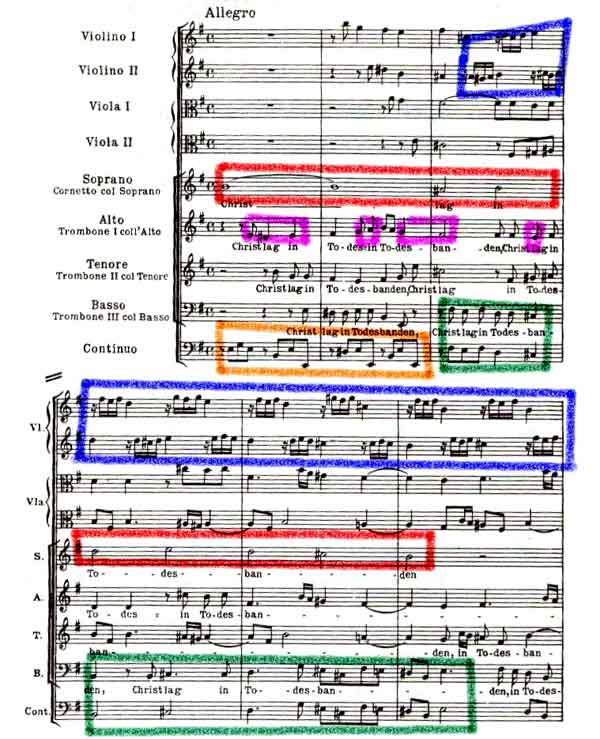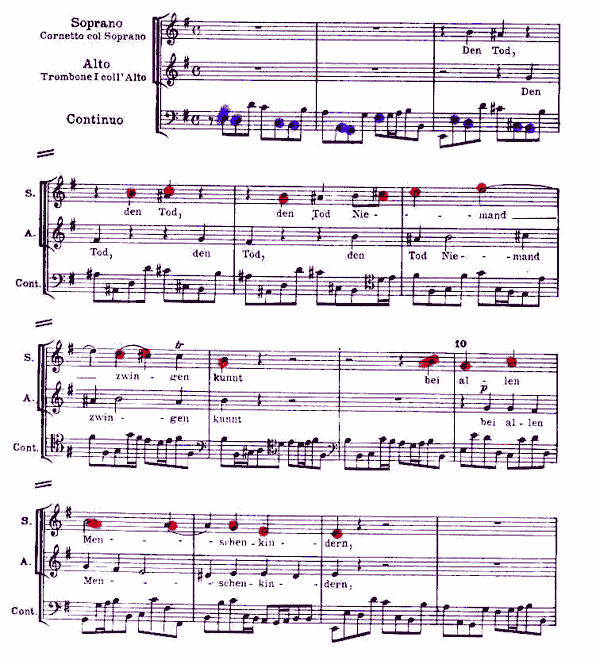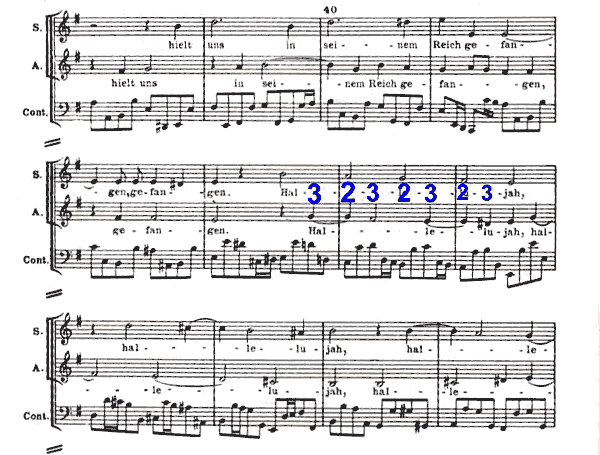Cantata BWV 4, Christ lag in Todes Banden, is surely one of the most popular and best known of all of Bach’s sacred cantatas. Written around the same time as Cantata 106, it is another example of a chorale cantata by Bach. All movements, including the opening sinfonia, make use of the chorale tune and/or text in some fashion. The chorale was written by Martin Luther, and is based on the Catholic chant “Victimae paschali laudes.” You can see the similarities in the shape of the melodies below. “Victimae” is traditionally written and sung in the D-Dorian mode, the same mode Luther originally used for his chorale, although Bach transposes it in the cantata.


Cantata 4 was written for Easter Sunday, though the date of the first performance is not clear. Stylistically, the work appears to have been written around 1707-1708, and it may be Bach’s earliest surviving sacred vocal composition. Some have suggested that it may have been written as an audition piece for Bach’s Mühlhausen position (Schulenberg).
Below is a summary of the movements of Cantata 4:
| Movt. | Meter and tempo | Key | Text | Texture | Scoring |
|---|---|---|---|---|---|
| Sinfonia | 4/4, slow | E minor | None | Homophonic | Strings and continuo |
| 1 | 4/4, allegro | E minor | Verse 1 of chorale | Polyphonic chorale fantasy | SATB choir, strings, continuo, cornet, 3 trombones |
| 2 | 4/4, slow | E minor | Verse 2 of chorale | Duet for SA, with walking bass in continuo; trio sonata | SA solos (doubled by cornet and 1 trombone), with continuo |
| 3 | 4/4, moderate to fast | E minor | Verse 3 of chorale | Trio sonata | Solo tenor; violins in unison, continuo |
| 4 | 4/4, moderate to fast | E minor | Verse 4 of chorale | Polyphonic and imitative, woven around chorale melody | SATB choir, continuo |
| 5 | 3/4, moderate to fast | E minor | Verse 5 of chorale | Homophonic with elaborate continuo line | Solo bass with strings and continuo |
| 6 | 4/4, moderate to fast | E minor | Verse 6 of chorale | Duet, using trio sonata texture with extensive imitation | Solo soprano, solo tenor, continuo |
| 7 | 4/4, moderate to slow | E minor | Verse 7 of chorale | 4-part chorale setting | SATB choir (doubled by strings, cornet, and trombones), continuo (doubling the bass line) |
The final movement requires some explanation. Most scores include a traditional four-part chorale setting here. The oldest surviving score for Cantata 4 dates from 1724; this score includes the four-part chorale setting. However, this kind of setting does not occur in cantatas from early in Bach’s career. It is likely, therefore, that this movement is an addition, or perhaps a substitution for another final movement, added for a Leipzig performance (Wollny).
You’ll notice from the chart above that every movement is in E minor – a bit unusual. More commonly, at least in his later works, Bach will include some movements in related keys (in this case, perhaps G Major or B minor), just for some variety. In addition, you’ll note that every movement uses text from Luther’s chorale; there are no poetic interpolations, such as we see in Cantata 140 (Wachet auf). Finally, Bach’s orchestra for Cantata 4 is not particularly colorful. The cornet and trombones exist merely to double the voices – a common practice well into the later decades of the 18th century (for example, in numerous sacred choral works by Mozart). They do not act independently of the voices, and therefore do not add any particular color to the orchestra. With little variety in the timbres, text, or key, Bach must look elsewhere for musical interest in Cantata 4 – the texture and methods of incorporating the chorale tune into the eight movements.
You can see the structure Bach sets up for Cantata 4. Looking only at the vocal parts, you can see choral movement – duet – solo, leading to a choral movement in the middle; but the reverse occurs from here out: solo – duet – choral movement.
The sinfonia which opens the cantata is very brief, a mere 14 measures for strings and continuo. The string parts include violin I and II, and viola I and II. (The split viola parts continue in all movements which include the upper strings – movements I, V, and VII). The chorale is not found in its entirety; rather, motives from the opening phrases are scattered throughout the sinfonia. Most notable is the E-D-sharp-E-F-sharp in the bass line, which follows the opening pitches (up one whole step) of the chorale tune. One might be surprised at the sombre tone of the sinfonia, since the cantata is written for Easter, the most joyous of Christian holy days. But recall the text: Christ lay in the bonds of death. The joy of Easter, however, begins with the sorrowful scene of his death on the cross and his entombment.
The first choral movement is a chorale fantasy with the chorale tune appearing in very long notes in the soprano (doubled by cornet), while the lower voices (doubled by trombones) propel the music forward with much more activity. Because of the short sinfonia, there is no need for an instrumental introduction in this movement; instead, Bach starts immediately with the voices. In fact, he starts with the chorale tune in the soprano (marked in red), unaccompanied for a brief moment. The continuo line is active, sometimes performing independently like a walking bass line (marked in orange), other times doubling the choral bass (marked in green). The alto part is an elaboration of the chorale melody (marked in pink), which is hidden through rhythmic and melodic elaborations. The viola parts essentially doubles and enhances the vocal alto and tenor parts, while the violin parts further activate the texture with a virtually continuous exchange of sixteenth-note snippets (marked in blue):

Each verse of the chorale text ends with the word “Hallelujah”. When Bach reaches this final word for the first verse, he breaks off the complicated chorale fantasy texture for a four-voice fugue (the strings and continuo double the choral parts).
The second verse is a duet for soprano and alto, with a walking bass accompaniment. Notice how the continuo part is essentially an ornamental descending scale passage (note the blue markings). The soprano clearly sings the chorale melody (marked in red) while the alto sings a related, though not exact, echo. The two melody parts together with the continuo make this duet a trio sonata in texture, though it is a relatively uncomplicated texture at that.

My favorite passage comes at the “Hallelujah”. Here, Bach writes what is a very simple line of suspensions, but this is a classic example (for students of music theory) of the use of the “Corelli clash” – a series of 2-3 suspensions – in real music:

In the third movement, the solo tenor sings a rather straightforward version of the chorale tune. All the ornamentation falls upon the violins (I and II, together). The resulting texture is another trio sonata, though here the parts are not entirely equal, as was the case in the preceding movement.
In movement four, the tenor again introduces the chorale tune, in an imitative passage. Eventually, the alto voice takes over the chorale tune in a much more simple, clear, obvious fashion. The continuo doubles the choral tenor or bass line, never acting independently. This highly contrapuntal, complicated texture carries through the entire work.
Movement five presents in some ways with the most variety. It is the only movement NOT in quadruple meter. Bach begins the movement deceptively, with a short passage in the continuo of descending chromatic steps – reminiscent of the opening of the Crucifixus movement of the Mass in B Minor. By the fifth pitch, however, the solo bass comes in with the chorale tune, and the continuo changes its tune, so to speak, moving to a dance-like passage of continuous eighth notes. At the end of measure six, the bass joins the continuo line temporarily and the strings of the orchestra enter with the chorale tune instead.

Movement six contains a rhythmic ostinato, with almost constant dotted eighth-sixteenth notes throughout. The chorale tune is presented in long notes (quarter), sometimes in the solo soprano, sometimes in the solo tenor. Initially, Bach introduces the tune in E minor, but then the tenor shifts to B minor for his statement. The two keys alternate throughout the movement.


































